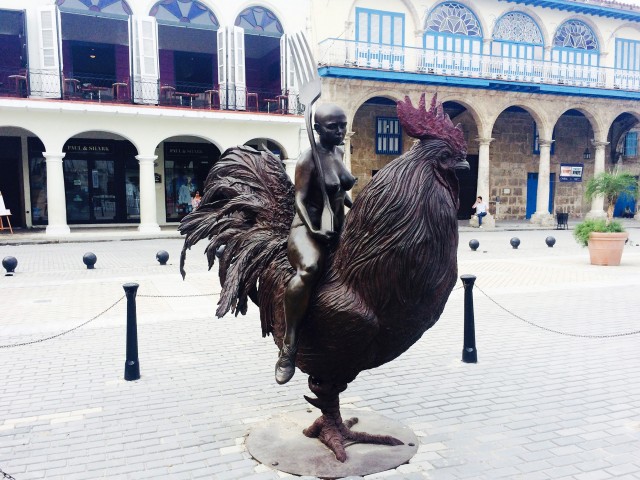The confidence to be who you are. Image by Tibor Végh via Wikimedia Commons.
The Modesty of Catholic School
I went to an all-girls Catholic school. My uniform was a blue-and-white pinafore with zigzag edges. The edges were meant to resemble petals, but in reality they reminded me of inverted ice cream cones.
Though we wore skirts, there was an unsaid rule of modesty. Nothing shorter than your knees.
There were some kids whose skirts were so long that they almost overlapped with their stark white socks. A daring few would let their skirts go shorter owing to a sudden growth spurt during summer break. But anything shorter than a few inches would result in a public chiding. We were usually careful; for a teenager there are few things worse than public embarrassment.
When we felt rebellious, we rolled down our socks and folded our sleeves. A teacher like Miss Sheela would pass by, and we’d reflexively unroll our socks and straighten up the sleeves.
I grew up and wore skirts, shorts, and swimsuits, but still there was a pattern for appropriate dressing that became hard to shake, even more so as an adult. It was an adult problem.
When What You Wear Transitions Into Who You Are
When I travelled it became obvious that these patterns were universal. Sure, in New York you could dress sexier than in Delhi. But the knot is always present; it’s looser, but it’s still there.
This dictum of dressing started being more than just hemlines and deep necks. It widened to involve body types, social classes, and trends. Ripped jeans meant you were too ghetto, unless you were Kylie Jenner. Boyfriend jeans meant you weren’t trying enough, or you were a soccer mom, unless of course you were Jennifer Aniston. The ideal toddler wears a frilly frock. If you are 70 and wear daisy dukes, you must be vapid and desperate for attention.
It’s a mind-numbing rulebook of yes’s and no’s.
So when I packed my bags for Cuba, I carried the usual excess baggage: dress for an exotic island.

Lessons from a Four-Year-Old Cuban
On my first day out in Havana, I saw a busload of kids jump onto the cobbled streets. They looked and sounded like most preschoolers: engaged in voluble chatter and exhibiting general disobedience, as their poor, harrowed teacher called for a single line file.
But the closer I looked, the lesser they seemed like me at four years old.
The girls wore hot pants, midriff-bearing crop tops, and skin-tight leopard-print leggings.
“Oh the horror!” the nuns in my school would have said.
I needed time to process this. I’d seen worse things than a toddler in a crop top, but my carefully crafted ideals of what was appropriate were altered. These kids didn’t look like Dora the Explorer. But did they need to? This wasn’t a reality show where an obviously exploited four-year-old kid wore too much makeup, spoke precociously to her pageant mom, and danced to a Katy Perry song about one-night stands. These were kids being kids.
Was I just making silly distinctions on what was appropriate and what was not?
This openness with the body didn’t just end with kids: High school girls wore mustard skirts that would be considered racy by American standards and shirts that would send the average school administration into a fit. But there was no cheerleader syndrome here.
This sort of irreverence for skirt lengths, decolletage, fit and form was diligently followed by Cuban adults. It’s a brilliant atmosphere where shape doesn’t determine fit. A curvy woman pulls off a slinky Lycra top that I was programmed to believe only looks good on models. No skinny jeans here; just jeans.
Owning It

While there are plenty of women around the world who show us that the way we look shouldn’t determine how we dress, that confidence is rarely an epidemic. In Cuba, the confidence seemed like a national average. Diffidence for rigid ideals seemed as much a part of the Cuban culture as vintage cars, cigarettes, and peso pizzas.
I’m not sure what causes many Cuban women to appear more confident. Did the Communist movement help in controlling media that propagates unfair standards of beauty ? There are no advertisements in Cuba – no life-size posters of supermodels telling you skinny is in. Or maybe this is the the Cuban standard of beauty, and they’d scoff at a front page cover of French Vogue and find its waif-thin model wildly unattractive.
Whatever the reason, the freedom from appropriateness felt refreshing. This is not to say there isn’t a Cuban teenager who thinks she isn’t good enough or that Cuban woman aren’t fetishised for their bodies.
But the average Cuban woman, to me, seemed happier with her body than many of my friends across the globe.
Collective confidence is an epidemic. As a result, I felt better about my body. In fact, I wore a dress I’d sworn to revisit when my legs got skinny enough. I ripped that one-year tag off, and I rocked that outfit.
